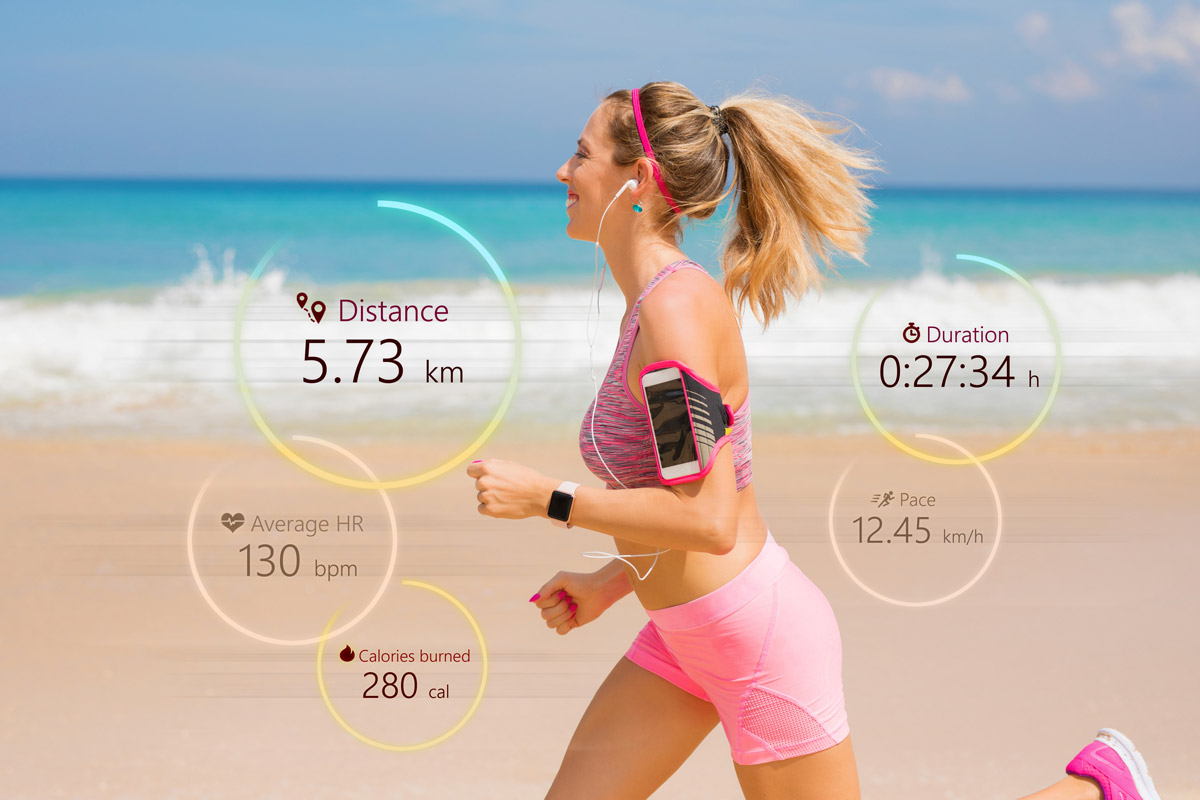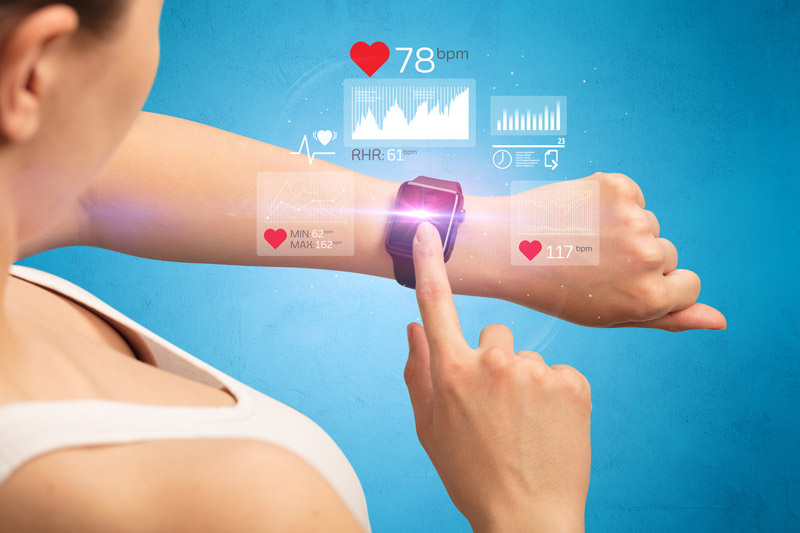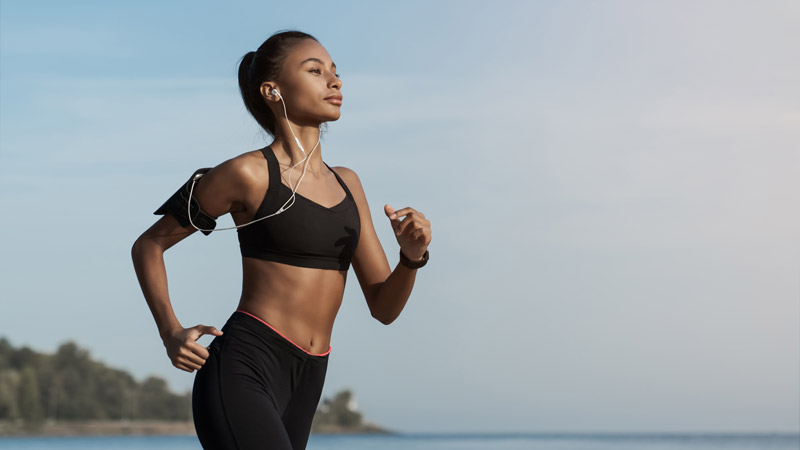The Definitive Guide to Wearable Fitness for Weight Management

Despite all of the negativity, why not give yourself credit for the movement you can achieve during a busy lifestyle?
One such way to keep up with a modern body in motion is through the use of wearable fitness trackers. According to Forbes and the International Federation of Sports Medicine, wearable fitness technology is the top fitness trend of the incoming decade.
Although these trackers can sound sci-fi and abstract at first, you may be surprised to find yourself already ahead of the curve with current use of technology in your daily life.
What is Wearable Fitness?
Wearable fitness is the use of hands-free devices that supplement your exercise routine. By design, these devices can provide and collect data to improve your exercise habits.
Although modern wearable technology is certainly innovative, the use wearable devices has technically existed for centuries. For example, the advent of eyeglasses and eyepieces in the 13th century and timepieces in the 15th century are both examples how people used wearable objects to achieve lifestyle goals. The primary difference today is the speed with which devices can send relevant information.
What are the Different Types of Wearable Trackers?
Wearable technology is a great way to ensure that your workout is effective regardless of location or chosen activity. There are four main categories of wearable trackers:
- Fitness Trackers and Activity Trackers – Fitness and activity trackers are wristbands or pocket watches that provide progress information on your notable activities. Some fitness trackers also have settings to monitor your sleep cycles if desired.Another major convenience of these devices is that they can usually sync with your smartphone for round-the-clock access to your fitness milestones. Many fitness professionals recommend these devices as the best choices for beginners. These wearable devices may have rehabilitative purposes as well. For example, some caregivers believe that wearing an activity tracker provides additional protection against dangerous slips and falls among the elderly.
- Heart Rate Monitors – Gone are the days in which you had to manually calculate your target heart rate. A heart rate monitor provides a real-time measurement to ensure accuracy during any workout.There are two types of heart rate monitors:
- Chest-Strap Monitors – Worn near your torso, these devices measure heartbeat close to the source and send information to a wrist receiver for maximum accuracy and precision.
- Strapless Monitors – These devices simply attach to wrist or clothing and measure heart rate using a built-in sensor. They are easier to wear but may not be as precisely accurate as the chest-strap option.
In the past, you would need to first calculate your resting heart rate by locating the carotid artery in your neck, counting the number of beats in 10 seconds, and then multiplying by six to get your 60-second resting heart rate (beats per minute). For instance, if you counted eight beats in 10 seconds, 8 x 6 = 48 beats per minute.
You would also need to calculate your target heart rate during exercise by subtracting your age from the number 220. So if you are 40 years old, you would need to subtract 40 from 220 to get a maximum target heart rate of 180 bpm. This is the maximum average number of beats per minute your heart should have during exercise.
In contrast, using a heart rate monitor eliminates the math by providing stats in real time. A monitor may also help ensure greater accuracy than conventional exercise methods (such as using the radial artery on your wrist).
Heart rate monitors are ideal for athletes or anyone who needs to make the most of a cardiovascular workout routine. Using this device may also alert you to any abnormalities that you may wish to discuss with your healthcare provider as needed.
- Running Watches – Running watches can help transform a simple jog into a calorie-burning power session. Whether you are interval training or planning for a marathon, these watches bring guidance to the track field. These trackers measure distance, laps, and interval log to keep you up to speed.
- GPS Watches – Global positioning is not just for cars anymore. A GPS watch can help you navigate your running path, measure speed, and monitor distance at your own pace. In addition, these types of devices can help you safely scout or map out a new running course so that exercise never gets boring. Since many GPS watches are waterproof, you can use this same tracker to log laps and speed while swimming.
What are Some of the Best Ways to Use Wearable Fitness Trackers?
Wearable fitness trackers are viable tools to take your workout to the next level. The best way to use a tracker is to take advantage of features that are not typically available on manual or analog device. Unique ways of using wearable fitness technology include the following:
- Step Tracker
Pack away your old pedometer. Smart devices can employ accelerometers and altimeters to measure entire distance traveled, providing you with insights on room for improvement. - Calorie Counter
Fitness trackers can offer information on how many calories (and calories from fat) you have burned during a given workout. Plus, many offer downloadable dieting apps that can show how many calories you have consumed throughout the day. - Sleep Monitor
Trackers with sleep cycle options can not only tell you have much you have slept, but also provide information on how much restful REM (rapid-eye movement) sleep you have achieved. Since studieshave shown a direct relationship between successful weight management and a good night’s sleep, using a sleep monitor may help you create a more well-rounded fitness plan. - Goal Setting
Most fitness trackers include alerts and notification settings to help keep users accountable for reaching their personal goals. - Network Connecting
Since the majority of fitness trackers are wireless, you can sync them with your smartphone, display monitor, or related device. Furthermore, this connectivity makes it easier to link with other fitness enthusiasts via online groups and forums.
How Do I Choose the Best Wearable Device for Me?
The best device is one that you can commit to using consistently to achieve your fitness goals. After all, there are few things worse than buying a new gadget only to abandon it within days or weeks. The following guidelines can help you select a device that best integrates with your existing needs.
Decide Your Type
Do you need a discreet, portable wristband so that you can count steps during work or play? Or can you use a larger strap monitor to gather precise data during HIIT (high intensity interval training) workouts? Deciding the type of tracker (including any display options) can help narrow your choices quickly.- Decide Your Sport
Will you need a GPS monitor to go the distance exploring the Australian outback? Or is the main purpose to use the tracker to help meet sleep and morning workout minimums? Deciding on the intensity and requirements of your sport is a great way to ensure that your device has all of the necessary features. - Determine Your Objectives and Expectations
How will you measure success? Do you plan to keep an online journal or post stats publicly on a fitness forum? Keeping an extensive record of your daily reports can help you put the tracker’s data collection to good use. - Develop a Reward System
What is more satisfying than seeing quantifiable proof of your fitness milestones? Creating a reward system to show for it. For example, you might set up a reward jar and insert a few dollars each evening after meeting your goals. Use the contents of the money jar to reward yourself with a full-body massage (or another fitness-related prize) at the end of the week or month.
The Bottom Line
Since it is customary for people to carry smartphones and similar devices with them throughout the day, using wearable technology is a natural way to upgrade your workout routine. Incorporate the wearable device as a tool to better achieve the goal of living your best life.
https://www.healthdirect.gov.au/tips-for-getting-active
https://www.nih.gov/news-events/nih-research-matters/molecular-ties-between-lack-sleep-weight-gain
https://www.hopkinsmedicine.org/news/newsroom/news-releases/wearable-activity-trackers-a-reliable-tool-for-predicting-death-risk-in-older-adults
https://www.sba.gov/blog/how-wearable-tech-can-help-you-achieve-better-business-performance
https://www.ncbi.nlm.nih.gov/pmc/articles/PMC5887043
https://www.betterhealth.vic.gov.au/health/HealthyLiving/exercise-intensity?viewAsPdf=true
https://www.ncbi.nlm.nih.gov/pmc/articles/PMC5917084

 You would also need to calculate your target heart rate during exercise by subtracting your age from the number 220. So if you are 40 years old, you would need to subtract 40 from 220 to get a maximum target heart rate of 180 bpm. This is the maximum average number of beats per minute your heart should have during exercise.
You would also need to calculate your target heart rate during exercise by subtracting your age from the number 220. So if you are 40 years old, you would need to subtract 40 from 220 to get a maximum target heart rate of 180 bpm. This is the maximum average number of beats per minute your heart should have during exercise. Decide Your Type
Decide Your Type